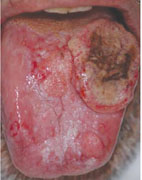6.2.6 Oral cancer
In Study Session 3 of this Module you studied the different types of cancers, with particular focus on cancers of the breast and female cervix. Oral cancer in the mouth is a less common cause of disability and death, which is often neglected because the signs and symptoms are not recognised, or are thought to be due to infection in the mouth. The signs are white and red patches inside the mouth or lips (Figure 6.9), swelling, blisters and ulcers, difficulty in swallowing, ear pain, loose teeth, and bleeding from the mouth. These signs should alert you to refer the person urgently to a higher health facility for specialist evaluation.

In most countries, the incidence of oral cancers is between one and ten new cases arising every year per 100,000 population. In the Ethiopian population of approximately 80 million people, how many new cases of oral cancer would you expect in a single year?
80 million divided by 100,000 = 8,000. So if there is only one new case per 100,000 population in Ethiopia, you would expect 8,000 new cases of oral cancer to develop in a single year. There would be ten times this number (80,000 cases) if the incidence rate was 10 new cases per 100,000 population.
Two known causes of oral cancer are tobacco and alcohol. Eighty to 90% of oral cancers come from smoking cigarettes, cigars or pipes, chewing tobacco or khat. The longer a person has used tobacco, the higher is their risk of developing cancers, including oral cancer, as well as lung and other cancers. People who use a pipe for smoking tobacco are especially prone to cancer of the lip. When a person stops using tobacco, they greatly reduce the risk of developing oral cancer. Strong alcoholic drinks (‘spirits’ like whisky and brandy) are damaging to the delicate membranes in the mouth, and prolonged use over several years increases the risk of developing oral cancers.
6.2.5 Eroded or broken teeth
